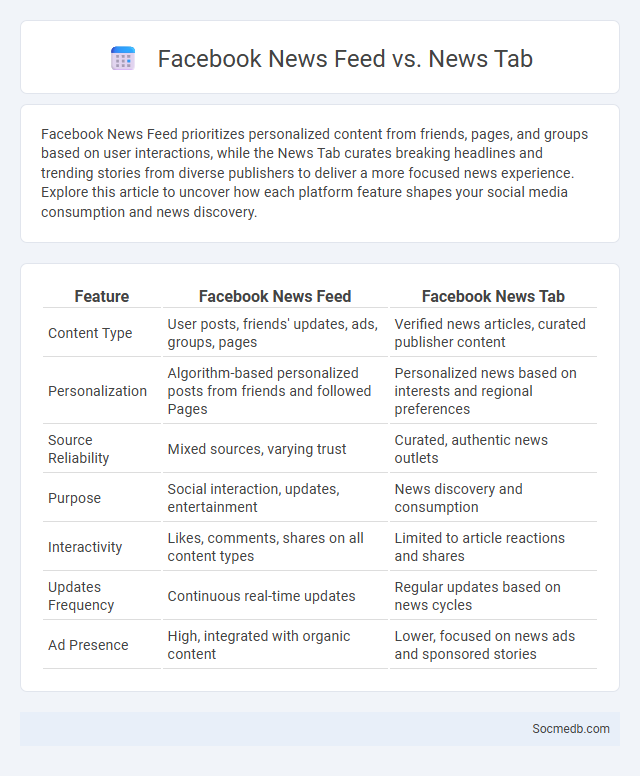
Photo illustration: Facebook News Feed vs News Tab
Facebook News Feed prioritizes personalized content from friends, pages, and groups based on user interactions, while the News Tab curates breaking headlines and trending stories from diverse publishers to deliver a more focused news experience. Explore this article to uncover how each platform feature shapes your social media consumption and news discovery.
Table of Comparison
| Feature | Facebook News Feed | Facebook News Tab |
|---|---|---|
| Content Type | User posts, friends' updates, ads, groups, pages | Verified news articles, curated publisher content |
| Personalization | Algorithm-based personalized posts from friends and followed Pages | Personalized news based on interests and regional preferences |
| Source Reliability | Mixed sources, varying trust | Curated, authentic news outlets |
| Purpose | Social interaction, updates, entertainment | News discovery and consumption |
| Interactivity | Likes, comments, shares on all content types | Limited to article reactions and shares |
| Updates Frequency | Continuous real-time updates | Regular updates based on news cycles |
| Ad Presence | High, integrated with organic content | Lower, focused on news ads and sponsored stories |
Introduction to Facebook News Consumption
Facebook remains a dominant platform for news consumption, with over 2.9 billion monthly active users engaging with diverse content daily. Its algorithm curates personalized news feeds based on your interests, interactions, and social connections, enhancing relevance and user engagement. Understanding how Facebook's news delivery works helps you navigate information sources critically and avoid misinformation.
Defining the Facebook News Feed
The Facebook News Feed is an algorithm-driven content stream that aggregates posts, photos, and videos from friends, pages, and groups a user follows. It prioritizes content based on relevance, user interactions, and timeliness to deliver a personalized experience. This dynamic feed constantly updates to reflect trending topics, sponsored ads, and recent activities within a user's network.
Exploring the Facebook News Tab
The Facebook News Tab aggregates trending and personalized news stories by leveraging advanced algorithms and user behavior data to deliver relevant content. It enables users to discover a diverse range of topics from reputable publishers worldwide, enhancing engagement through real-time updates. Integration with Facebook's broader social ecosystem facilitates sharing and discussion, driving higher retention and platform interaction.
Key Differences Between News Feed and News Tab
The News Feed on social media platforms displays a real-time, algorithm-driven stream of posts from friends, pages, and groups a user follows, prioritizing engagement and recency. The News Tab, often curated, aggregates trending stories, breaking news, and personalized content from various publishers, emphasizing relevance and credibility over social interaction. User interaction on the News Feed revolves around sharing and commenting, whereas the News Tab focuses on content discovery and consumption.
Content Sources and Algorithms
Social media platforms prioritize content sources based on user engagement and relevance, leveraging sophisticated algorithms to curate personalized feeds. These algorithms analyze your behavior, such as likes, shares, and comments, to deliver tailored content that aligns with your interests. Understanding how content sources and algorithms work helps optimize your social media experience and maximize meaningful interactions.
User Experience: Personalization and Engagement
Social media platforms leverage advanced algorithms to deliver personalized content, enhancing user experience by tailoring feeds to individual preferences and behaviors. Features like targeted recommendations, interactive stories, and real-time notifications foster deeper engagement and sustained user interaction. Enhanced personalization strategies drive higher retention rates and improve platform relevance in users' daily digital activities.
Impact on Publishers and Content Creators
Social media platforms have revolutionized the landscape for publishers and content creators by providing unprecedented access to global audiences, enabling targeted content distribution and real-time engagement metrics. The algorithms driving platforms like Facebook, Instagram, and TikTok prioritize user interaction, which affects content visibility and shapes monetization strategies through ad revenue and sponsored content. This dynamic environment demands continuous content innovation and audience analytics to maintain relevance and maximize revenue potential.
Managing Fake News and Misinformation
Managing fake news and misinformation on social media requires robust fact-checking algorithms and user education initiatives to promote digital literacy. Platforms must implement real-time content verification systems to detect and flag false information, reducing its spread. Your active participation in reporting suspicious posts and verifying sources enhances the overall integrity of the social media environment.
Regional Availability and Market Differences
Social media platforms vary significantly in regional availability due to local regulations, language preferences, and cultural norms. Understanding these market differences helps tailor your content strategy effectively to engage diverse audiences across Asia, Europe, and the Americas. Your approach should consider platform popularity, user behavior, and compliance requirements specific to each region for optimized reach and interaction.
Future Trends in Facebook News Features
Facebook is expected to advance AI-driven news personalization to enhance user engagement by delivering highly relevant content tailored to individual preferences. The platform is also likely to integrate augmented reality (AR) elements within news stories to promote immersive storytelling experiences. Enhanced fact-checking technologies and partnerships with credible news organizations will further combat misinformation and improve news credibility on Facebook.
 socmedb.com
socmedb.com